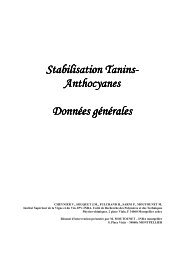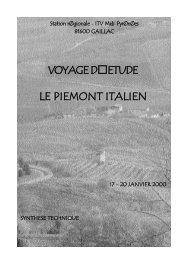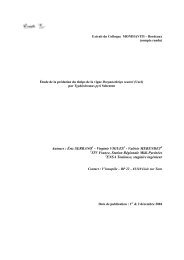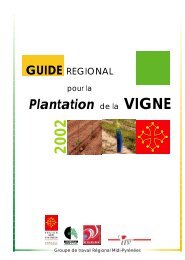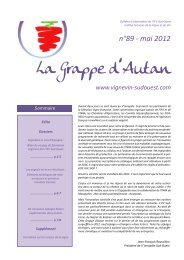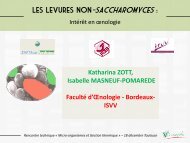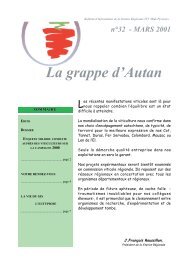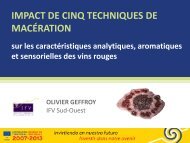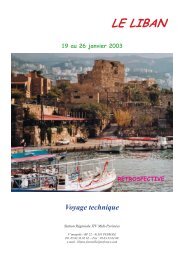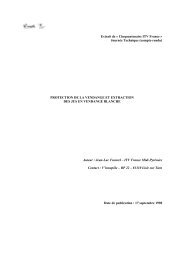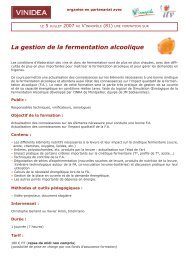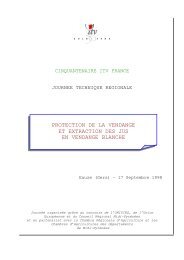Author's personal copyAvailable online at www.sciencedirect.comFood Chemistry 107 (2008) 1661–1667Analytical MethodsHighlight on the problems generated by p-coumaric acidanalysis in wine fermentationsDominique Salameh a,b, *,Cédric Brandam a , Wissam Medawar b ,Roger Lteif b , Pierre Strehaiano aa Laboratoire <strong>de</strong> Génie Chimique, UMR CNRS 5503, 5 Rue Paulin Talabot, 31106 Toulouse, Franceb Université Saint-Joseph, Faculté <strong>de</strong>s Sciences. Mar Roukoz, Mkallès, P.O. Box 11514, Beirut 1107-2050, LebanonReceived 13 December 2006; received in revised form 13 September 2007; accepted 15 September 2007FoodChemistrywww.elsevier.com/locate/foodchemAbstractp-Coumaric acid is a natural hydroxycinnamic acid existing in grapes and wine. It is the precursor of the 4-ethylphenol moleculethrough the bioconversion reaction by <strong>Brettanomyces</strong> yeast. Chromatographic methods are the most common techniques to <strong>de</strong>tect p-coumaricacid. It is known that this acid is highly unstable in analysis and fermentation experiments. This paper highlights the problemsoccurring in p-coumaric acid analysis in wine fermentation conditions when studying its bioconversion. First, it was shown that p-coumaricacid was unstable at elevated temperature. On the other hand, it was found that in our experimental conditions p-coumaric acidreacted with ethanol. This work revealed also that the p-coumaric acid is <strong>par</strong>tially adsorbed on <strong>Brettanomyces</strong> yeast, certainly on cellwalls. Because of these phenomena the quantity of p-coumaric acid which can <strong>par</strong>ticipate to the bioconversion into ethylphenol<strong>de</strong>creases.Ó 2007 Elsevier Ltd. All rights reserved.Keywords: p-Coumaric acid; Chromatographic analysis; Temperature; Adsorption; Ethanol; <strong>Brettanomyces</strong>; Fermentation1. Introductionp-Coumaric acid is a natural hydroxycinnamic phenolicacid that exists in wine in an esterified form with tartaricacid, the tartaric p-coumaroyl ester. It can also exist as glucoseheterosi<strong>de</strong> (Ribereau-Gayon, Glories, Maujean, &Dubourdieu, 1998). In grapes, p-coumaric acid is a polyphenolprecursor, especially for flavonoids, flavones andflavonols (Hrazdina, Parsons, & Mattick, 1984). This acidis equally a crucial substrate for enzymes to create resveratrol(Goldberg, Tsang, Karumanchiri, & Soleas, 1998). Ingrape juice, the p-coumaric acid can reach a concentrationof 60 mg/l (Chatonnet, Viala, & Dubourdieu, 1997), but it* Corresponding author. Address: Laboratoire <strong>de</strong> Génie Chimique,UMR CNRS 5503, 5 Rue Paulin Talabot, 31106 Toulouse, France. Tel.:+33 630962994; fax: +33 534615253.E-mail address: dominique.salameh@usj.edu.lb (D. Salameh).does not reach more than 8 mg/l in wine (Goldberg et al.,1998).During the fermentation, p-coumaric acid is liberateddue to the action of esterase activity in yeast and it seemsnowadays that the sequential action of two enzymes onthe free p-coumaric acid could be the principal cause ofethylphenol production in wine (Baumes & Cordonnier,1986; Chatonnet & Boidron, 1988; Dubois, Brule, & Illic,1971; Etievant, 1981; Schimidzu & Watanabe, 1982). Firsthydroxycinnamate <strong>de</strong>carboxylase changes the hydroxycinnamicacid into a hydroxystyrene (vinylphenol) (Edlin, Narbad,Gasson, Dickinson, & Lloyd, 1998), which is thenreduced to ethyl <strong>de</strong>rivatives by vinylphenol reductase (Dias,Pereira-da-Silva, Tavares, Malfeito-Ferreira, & Loureiro,2003). Moreover, many authors proved that ethylphenoloccurrence is due to the presence of <strong>Brettanomyces</strong> sp. yeastand its spore Dekkera (Chatonnet, Dubourdieu, Boidron, &Pons, 1992; Dias et al., 2003; Edlin, Narbad, & Lloyd,0308-8146/$ - see front matter Ó 2007 Elsevier Ltd. All rights reserved.doi:10.1016/j.foodchem.2007.09.052
Author's personal copy1662 D. Salameh et al. / Food Chemistry 107 (2008) 1661–16671995). In fact, the first enzyme, hydroxycinnamate <strong>de</strong>carboxylase,exists within a large number of bacteria and yeast,but the second, vinylphenol reductase, is only performed bya few yeast species like <strong>Brettanomyces</strong> sp.Yeast of the genus Dekkera/<strong>Brettanomyces</strong>, especiallyD. bruxellensis species, is able to produce importantamount of ethylphenols in wine, mainly 4-ethylguaiacoland 4-ethylphenol. The problem is that 4-ethylphenol moleculeis associated in sensorial analysis to horse sweat smellor mousy taint flavours. Because of its bad organolepticimpact on wine, <strong>Brettanomyces</strong> sp. is consi<strong>de</strong>red as contaminatingyeast.In the literature, the problem is mentioned over andover, certainly because the quality of wine and productivityin winemaking are nowadays main factors than they werewith the increasing competitive world wine market. Ethylphenolpresence in wine is responsible of great economicalloss and its production is much more <strong>de</strong>tected (Chatonnetet al., 1997).This is a main reason to stop this phenomenon in winemakingindustries. It is very difficult to avoid <strong>Brettanomyces</strong>sp. growth in wine first because of the low hygiene levelwhich can be reached in winemaking, second because of theresistance and growth of this yeast in strict conditions (lowlevels of sugar, high levels of ethanol) (Suárez, Suárez-Lepe, Morata, & Cal<strong>de</strong>rón, 2007). A way to struggleagainst ethylphenol production would be to avoid the bioconversionof p-coumaric acid into ethylphenols ratherthan avoiding <strong>Brettanomyces</strong> presence.Thus, we must have a full un<strong>de</strong>rstanding of the bioconversionmechanism. Authors usually show out the ethylphenoloccurrence in wine versus <strong>Brettanomyces</strong> presence,without mentioning p-coumaric acid when studying its bioconversion.Yet, it would be very useful to have kinetics ofp-coumaric acid bioconversion into vinylphenol, then intoethylphenol. Equally, the following up of the p-coumaricacid would be interesting in or<strong>de</strong>r to provi<strong>de</strong> valuable datain yield calculation. So, according to us, it appears absolutelynecessary to follow up products, substrates and havegood methods to measure them.The most common techniques that <strong>de</strong>tect p-coumaricacid in its media are chromatographic methods. Medawar(2003) showed a difference between the initial concentrationof the p-coumaric acid ad<strong>de</strong>d to fermentation andthe one <strong>de</strong>tected by HPLC just after adding the acid. Wenoticed the same problem while we were studying the bioconversionof p-coumaric acid into ethylphenols in ourexperiments. These observations ma<strong>de</strong> us to search forthe origin of this p-coumaric acid loss. What does coumaricacid turn to in a wine (synthetic) medium?In this field of art, authors pointed out several mechanismsof physical, chemical or biochemical reactivity ofhydroxycinnamic acids in wine mediums. First, Medawar(2003) suspected that high sterilisation temperature isresponsible of the p-coumaric acid disappearance. In addition,it could be a solubility problem since p-coumaric acidis not easily soluble in water, neither in synthetic wine medium.That is why, before being ad<strong>de</strong>d, it should always bedissolved into pure ethanol which is the most common solvent(Tuzen & Oz<strong>de</strong>mir, 2003).Moreover, the p-coumaric acid, as all the phenolic compoundsdo, can un<strong>de</strong>rgo a polymerization reaction or anelectrophilic addition with other wine components, especiallyan electrophilic addition with ethanol that gives ethoxyphenolsin wine ageing (Dugelay, Beaumes, Guntata,Razungles, & Bayonove, 1995; Seyhane E., 1994). Severalauthors showed that p-coumaric acid can un<strong>de</strong>rgo an oxidation(Bagchi, Grag, Krohn, Bagchi, & Tran, 1997; Herrera,Pulgarin, Nadtochenko, & Kiwi, 1998), an esterification(Dugelay, Guntata, Sapis, Beaumes, & Bayonove, 1993), oran amination (Clark, 2000) un<strong>de</strong>r different conditions.These bibliographical observations lead to ask questionsabout the reactivity of p-coumaric acid in a fermentationmedium. On the other hand, when O’Neill, Christov, Botes,& Prior (1996) exposed an HPLC method for cinnamic acid<strong>de</strong>tection, they claimed that the correction should be donein function of each medium analysis, because of the adsorptionof the hydroxycinnamic acids on different mediumcomponents, as wheat bran in their case of study. We knowas well that phenolic compounds can adsorb on yeast cellwalls (Medina, Boido, Dellacassa, & Carrau, 2005; Morata,Gomez-Cordoves, Colomo, & Suárez, 2005; Morata et al.,2003; Rizzo, Ventrice, Varone, Sidari, & Caridi, 2006).All these phenomena can generate loss of p-coumaricacid in a wine synthetic medium. The goal of this paperis not to discuss the bioconversion of p-coumaric acid intoethylphenol, but to evaluate the chemical instability andthe physical availability of p-coumaric acid un<strong>de</strong>r ouroenological conditions, to <strong>de</strong>termine the exact quantitywhich can really <strong>par</strong>ticipate in the bioconversion.2. Materials and methods2.1. p-Coumaric acid <strong>de</strong>tectionStandard of p-coumaric acid used for all experimentswas acquired from Aldrich–Sigma society. As presentedin the market, p-coumaric acid has a white crystalline pow<strong>de</strong>raspect. All other chemicals were reagent gra<strong>de</strong> or better.Two ways have been employed to <strong>de</strong>tect p-coumaricacid:– UV <strong>de</strong>tection: the p-coumaric acid absorption was carriedout on a UV spectrophotometer at 305 nm in quartzcell. The p-coumaric acid belongs to the hydroxycinnamicacid family well known for its absorbance in theUV region of the spectra because of the mesomeric effectof the double bonds, and their phenolic cycle (Seyhane,1994). The polyphenols are <strong>de</strong>tectable then at low concentration(1–10 lM) (Barthelmebs, Divies, & Cavin,2000).– HPLC <strong>de</strong>tection: the p-coumaric acid analysis was carriedout by HPLC. The ODS-2 5u TM(Waters Ò ) columnfollowed a Spherimarge ODS-2 TMpre-column at 30 °C.
- Page 1 and 2:
N° d’ordre :………………TH
- Page 3 and 4:
Quantum potes, tantum aude …(St T
- Page 5 and 6:
Il l’appelait « la Saga » dans
- Page 7 and 8:
SommaireListe des Figures..........
- Page 9 and 10:
3.5.2. Spectroscopie en IR : Dosage
- Page 11 and 12:
5.2. Etude de l’évolution de la
- Page 13 and 14:
Liste des FiguresFigure I. 1. Proc
- Page 15:
Figure VI. 16. Vitesses de disparit
- Page 18 and 19:
Tableau V. 3. Différentes valeurs
- Page 20:
Introduction Générale1
- Page 23 and 24:
Introduction GénéraleCes deux ins
- Page 26:
SynthèseBibliographique7
- Page 29 and 30:
Synthèse BibliographiqueLors de l
- Page 31 and 32:
Synthèse BibliographiqueFigure I.
- Page 33 and 34:
Synthèse BibliographiqueA ces arô
- Page 35 and 36:
Synthèse BibliographiqueDepuis la
- Page 37 and 38:
Synthèse Bibliographique4.1. Prés
- Page 39 and 40:
Synthèse BibliographiqueLe meilleu
- Page 41 and 42:
Synthèse BibliographiqueCH 2CH 2CH
- Page 43 and 44:
Synthèse BibliographiqueTableau I.
- Page 45 and 46:
Synthèse BibliographiqueLe 4-vinyl
- Page 47 and 48:
Synthèse BibliographiqueAinsi, la
- Page 49 and 50:
Synthèse Bibliographiquerend l’e
- Page 51 and 52:
Synthèse BibliographiqueAinsi, l
- Page 53 and 54:
Synthèse BibliographiqueEn contrad
- Page 55 and 56:
Synthèse BibliographiqueLes traite
- Page 57 and 58:
Synthèse Bibliographiqued’extrac
- Page 59 and 60:
Synthèse BibliographiqueLa diverge
- Page 62 and 63:
Matériels et Méthodes1. Etude de
- Page 64 and 65:
Matériels et Méthodes1.3. Prépar
- Page 66 and 67:
Matériels et Méthodes1.7. Prélè
- Page 68 and 69:
Matériels et MéthodesUne fois l
- Page 70 and 71:
Matériels et MéthodesCar en effet
- Page 72 and 73:
Matériels et MéthodesLa concentra
- Page 74 and 75:
Matériels et MéthodesLe système
- Page 76 and 77:
Matériels et Méthodes3.5.1. Spect
- Page 78 and 79:
Matériels et Méthodes3.5.4.3.Cond
- Page 80 and 81:
Matériels et MéthodesSeptumVialPe
- Page 82 and 83:
Matériels et MéthodesLe Spectrosc
- Page 84:
Matériels et Méthodeso La vitesse
- Page 90 and 91:
Mise au point des methods analytiqu
- Page 92 and 93:
Mise au point des methods analytiqu
- Page 94 and 95:
Mise au point des methods analytiqu
- Page 96 and 97:
Mise au point des methods analytiqu
- Page 98 and 99:
Mise au point des methods analytiqu
- Page 100 and 101:
Mise au point des methods analytiqu
- Page 102 and 103:
Mise au point des methods analytiqu
- Page 104 and 105:
Mise au point des methods analytiqu
- Page 106 and 107:
Mise au point des methods analytiqu
- Page 108 and 109:
Mise au point des methods analytiqu
- Page 110:
Quatrième Chapitre :“Disponibili
- Page 113 and 114:
Disponibilité de l’acide p-couma
- Page 115 and 116:
Disponibilité de l’acide p-couma
- Page 117 and 118:
Disponibilité de l’acide p-couma
- Page 119 and 120:
Disponibilité de l’acide p-couma
- Page 121 and 122:
Disponibilité de l’acide p-couma
- Page 123 and 124:
Disponibilité de l’acide p-couma
- Page 125 and 126:
Disponibilité de l’acide p-couma
- Page 127 and 128:
Disponibilité de l’acide p-couma
- Page 129 and 130:
Disponibilité de l’acide p-couma
- Page 131 and 132:
Disponibilité de l’acide p-couma
- Page 133 and 134:
114
- Page 135 and 136:
116
- Page 137 and 138:
Traitement des vins par adsorption
- Page 139 and 140:
Traitement des vins par adsorption
- Page 141 and 142:
Traitement des vins par adsorption
- Page 143 and 144:
Traitement des vins par adsorption
- Page 145 and 146:
Traitement des vins par adsorption
- Page 147 and 148:
Traitement des vins par adsorption
- Page 149 and 150:
Traitement des vins par adsorption
- Page 151 and 152:
132
- Page 153 and 154:
134
- Page 155 and 156:
Etude cinétique de la bioconversio
- Page 157 and 158:
Etude cinétique de la bioconversio
- Page 159 and 160:
Etude cinétique de la bioconversio
- Page 161 and 162:
Etude cinétique de la bioconversio
- Page 163 and 164:
Etude cinétique de la bioconversio
- Page 165 and 166:
Etude cinétique de la bioconversio
- Page 167 and 168:
Etude cinétique de la bioconversio
- Page 169 and 170:
Etude cinétique de la bioconversio
- Page 171 and 172:
Etude cinétique de la bioconversio
- Page 173 and 174:
Etude cinétique de la bioconversio
- Page 175 and 176:
Etude cinétique de la bioconversio
- Page 177 and 178: Etude cinétique de la bioconversio
- Page 179 and 180: Etude cinétique de la bioconversio
- Page 181 and 182: Etude cinétique de la bioconversio
- Page 183 and 184: Etude cinétique de la bioconversio
- Page 185 and 186: Etude cinétique de la bioconversio
- Page 187 and 188: 168
- Page 189 and 190: 170
- Page 191 and 192: Conclusion GénéraleLa seconde tec
- Page 193 and 194: Conclusion GénéraleL’étude de
- Page 195 and 196: 176
- Page 197 and 198: • BAKKER J., TIMBERLAKE C.F. (199
- Page 199 and 200: • CASTRO MARTINEZ C. (2007). Bret
- Page 201 and 202: • DIAS L., PEREIRA-DA-SILVA S., T
- Page 203 and 204: F• FALCETTI M., ASSELIN C. (1996)
- Page 205 and 206: • GRBIN P.R., MARKIDES A.J., HENS
- Page 207 and 208: • LICKER J.L., ACREE T. E., HENIC
- Page 209 and 210: • MORATA A., GOMEZ-CORDOVES M.C.,
- Page 211 and 212: • RENOUF V., FALCOU M., MIOT-SERT
- Page 213 and 214: • SOLEAS G.J., TOMLINSON G., DIAM
- Page 215 and 216: Z• ZAFRILLA P., MORILLAS J., MULE
- Page 217 and 218: 198
- Page 219 and 220: Annexe 2Les Ecorces OFLes Ecorces O
- Page 221 and 222: Annexe 3CODEX OENOLOGIQUE INTERNATI
- Page 223 and 224: Publications197
- Page 225 and 226: ethanol before to be added in diffe
- Page 227: On the other hand, when the yeast c
- Page 231 and 232: Author's personal copy1664 D. Salam
- Page 233 and 234: Author's personal copy1666 D. Salam



